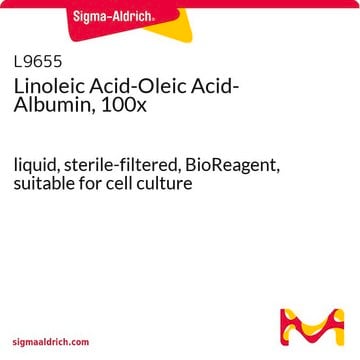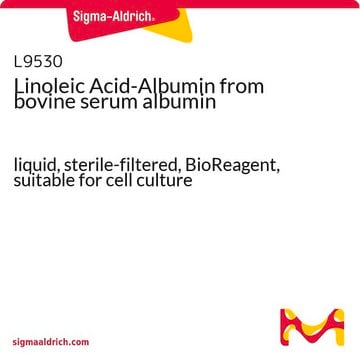The concentration of BSE in this product is approximately 100 mg/mL in DPBS. The lot-specific concentration is reported in the Certificate of Analysis as "Protein by Biuret". Please see the link below to review a sample or lot specific Certificate:
https://www.sigmaaldrich.com/product/sigma/o3008#product-documentation
O3008
Oleic Acid-Albumin from bovine serum
liquid, sterile-filtered, BioReagent, suitable for cell culture
Synonyme(s) :
Oleic acid-BSA complex
Sélectionner une taille de conditionnement
Sélectionner une taille de conditionnement
About This Item
Produits recommandés
Source biologique
bovine
Stérilité
sterile-filtered
Gamme de produits
BioReagent
Forme
liquid
Composition
Oleic acid, 2 mol/mol albumin
Concentration
100 mg/mL BSA in DPBS
90-120 mg/mL protein (biuret)
Technique(s)
cell culture | mammalian: suitable
Impuretés
endotoxin, tested
Température de stockage
2-8°C
Application
Actions biochimiques/physiologiques
Produit(s) apparenté(s)
Code de la classe de stockage
10 - Combustible liquids
Classe de danger pour l'eau (WGK)
WGK 3
Point d'éclair (°F)
Not applicable
Point d'éclair (°C)
Not applicable
Équipement de protection individuelle
Eyeshields, Gloves
Faites votre choix parmi les versions les plus récentes :
Certificats d'analyse (COA)
Vous ne trouvez pas la bonne version ?
Si vous avez besoin d'une version particulière, vous pouvez rechercher un certificat spécifique par le numéro de lot.
Déjà en possession de ce produit ?
Retrouvez la documentation relative aux produits que vous avez récemment achetés dans la Bibliothèque de documents.
Les clients ont également consulté
Articles
Supplement cell culture systems with fatty acids for biomanufacturing heterologous proteins like monoclonal antibodies.
How the unsaturated fatty acid, oleic acid and other cell culture components affect the performance of serum-free, protein-free cell culture systems used for biomanufacturing heterologous proteins including monoclonal antibodies.
-
What is the bsa concentration in the solution?
1 answer-
Helpful?
-
-
Is it suitable to store this reagent in -20C in aliquots? We received our order recently and the shipping box has a large label of "Do not Freeze" I was inquiring if there was a decrease in concentration if frozen?
1 answer-
To effectively preserve the integrity of this product, it should be stored at the recommended temperature and protected from light. The stability and optimal performance may be impacted by the freeze/thaw process. This product should be stored at 2 to 8 C.
Helpful?
-
-
How is the binding of oleic acid to BSA is confirmed?
1 answer-
Many fatty acids have a natural affinity to some plasma proteins. In this case BSA serves as a carrier or transporter of the insoluble oleic acid. The product is tested for protein and oleic acid content, only. No additional testing is performed to confirm the complex formation. See the following publications for further information:
https://pubmed.ncbi.nlm.nih.gov/236351/
https://pubmed.ncbi.nlm.nih.gov/19745557/#:~:text=Albumin%20acts%20as%20main%20fatty,a%20several%20orders%20of%20magnitudeHelpful?
-
-
What is the concentration of Oleic Acid in this product in Molarity (M) or milimolarity (mM)? I need this to be able to follow a protocol
1 answer-
Oleic acid has a molecular mass of 282.47 g/mol. In order to find the concentration of oleic acid in a specific lot, use the Oleic acid concentration on the lot-specific certificate of analysis (COA).
The equation used to find the concentration is as follows: (molar mass of Oleic acid) x (concentration of Oleic acid from COA), this will result in units of liter/mole which can be multiplied by the reciprocal, resulting in units of Molarity (mole/liter).
For example, for lot number SLCM9550, the Oleic acid concentration is reported as 940 ug/mL.
282.47 g/mol / 0.94 g/L =300.5 L/mol
1/300.5= 0.003327 M (mol/liter) = 3.33 mM Oleic AcidHelpful?
-
-
Through what method is oleic acid complexed to BSA?
1 answer-
Unfortunately, the method of preparation considered proprietary.
Helpful?
-
Active Filters
Notre équipe de scientifiques dispose d'une expérience dans tous les secteurs de la recherche, notamment en sciences de la vie, science des matériaux, synthèse chimique, chromatographie, analyse et dans de nombreux autres domaines..
Contacter notre Service technique







